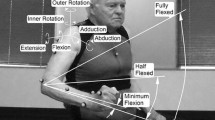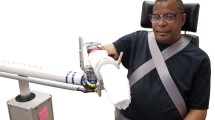Abstract
A stroke-related loss of corticospinal and corticobulbar pathways is postulated to result in an increased use of remaining neural substrates such as bulbospinal pathways as individuals with stroke are required to generate greater volitional shoulder abduction torques. The effect of shoulder abduction on upper extremity reaching range of motion (work area) was measured in 18 individuals with stroke using the Arm Coordination Training 3-D (ACT3D) device. This robotic system is capable of quantifying movement kinematics when a subject attempts to reach while simultaneously generating various levels of active shoulder abduction torque. We have provided data demonstrating an incremental increase of abnormal coupling of elbow flexion for greater levels of shoulder abduction in the paretic limb that results in a reduction in available work area as a function of active limb support. The progressive increase in the expression of abnormal shoulder/elbow coupling can be explained by a progressive reliance on the indirect cortico-bulbospinal connections that remain in individuals following a stroke-induced brain injury.







Similar content being viewed by others
References
Beer RF, Given JD, Dewald JP (1999) Task-dependent weakness at the elbow in patients with hemiparesis. Arch Phys Med Rehabil 80:766–772
Beer RF, Dewald JP, Rymer WZ (2000) Deficits in the coordination of multijoint arm movements in patients with hemiparesis: evidence for disturbed control of limb dynamics. Exp Brain Res 131:305–319
Beer RF, Dewald JP, Dawson ML, Rymer WZ (2004) Target-dependent differences between free and constrained arm movements in chronic hemiparesis. Exp Brain Res 156:458–470
Beer RF, Ellis MD, Holubar BG, Dewald JP (2007) Impact of gravity loading on post-stroke reaching and its relationship to weakness. Muscle Nerve [E-pub ahead of print]
Brunnstrom S (1970) Movement therapy in hemiplegia: a neurophysiological approach. Harper and Row, New York
Canning CG, Ada L, Adams R, O’Dwyer NJ (2004) Loss of strength contributes more to physical disability after stroke than loss of dexterity. Clin Rehabil 18:300–308
Cirstea MC, Levin MF (2000) Compensatory strategies for reaching in stroke. Brain 123(Pt 5):940–953
Cirstea MC, Mitnitski AB, Feldman AG, Levin MF (2003) Interjoint coordination dynamics during reaching in stroke. Exp Brain Res 151:289–300
Dewald JP, Beer RF (2001) Abnormal joint torque patterns in the paretic upper limb of subjects with hemiparesis. Muscle Nerve 24:273–283
Dewald JP, Pope PS, Given JD, Buchanan TS, Rymer WZ (1995) Abnormal muscle coactivation patterns during isometric torque generation at the elbow and shoulder in hemiparetic subjects. Brain 118(Pt 2):495–510
Dewald JP, Sheshadri V, Dawson ML, Beer RF (2001) Upper-limb discoordination in hemiparetic stroke: implications for neurorehabilitation. Top Stroke Rehabil 8(1):1–12
Ellis MD, Holubar BG, Acosta AM, Beer RF, Dewald JP (2005) Modifiability of abnormal isometric elbow and shoulder joint torque coupling after stroke. Muscle Nerve 32:170–178
Ellis MD, Acosta AM, Yao J, Dewald JP (2007) Position dependent torque coupling and associated muscle activation in the hemiparetic upper extremity. Exp Brain Res 176:594–602
Fugl-Meyer AR, Jaasko L, Leyman I, Olsson S, Steglind S (1975) The post-stroke hemiplegic patient. 1. a method for evaluation of physical performance. Scand J Rehabil Med 7:13–31
Gowland C, Stratford P, Ward M, Moreland J, Torresin W, Van Hullenaar S, Sanford J, Barreca S, Vanspall B, Plews N (1993) Measuring physical impairment and disability with the Chedoke-McMaster stroke assessment. Stroke 24:58–63
Kamper DG, McKenna-Cole AN, Kahn LE, Reinkensmeyer DJ (2002) Alterations in reaching after stroke and their relation to movement direction and impairment severity. Arch Phys Med Rehabil 83:702–707
Kuypers HG (1964) The descending pathways to the spinal cord, their anatomy and function. Prog Brain Res 11:178–202
Lum PS, Burgar CG, Shor PC (2003) Evidence for strength imbalances as a significant contributor to abnormal synergies in hemiparetic subjects. Muscle Nerve 27:211–221
Lynch D, Ferraro M, Krol J, Trudell CM, Christos P, Volpe BT (2005) Continuous passive motion improves shoulder joint integrity following stroke. Clin Rehabil 19:594–599
Matsuyama K, Mori F, Nakajima K, Drew T, Aoki M, Mori S (2004) Locomotor role of the corticoreticular-reticulospinal-spinal interneuronal system. Prog Brain Res 143:239–249
Mercier C, Bertrand AM, Bourbonnais D (2004) Differences in the magnitude and direction of forces during a submaximal matching task in hemiparetic subjects. Exp Brain Res 157:32–42
Newton JM, Ward NS, Parker GJ, Deichmann R, Alexander DC, Friston KJ, Frackowiak RS (2006) Non-invasive mapping of corticofugal fibres from multiple motor areas–relevance to stroke recovery. Brain 129:1844–1858
Reinkensmeyer DJ, McKenna Cole A, Kahn LE, Kamper DG (2002) Directional control of reaching is preserved following mild/moderate stroke and stochastically constrained following severe stroke. Exp Brain Res 143:525–530
Reisman DS, Scholz JP (2003) Aspects of joint coordination are preserved during pointing in persons with post-stroke hemiparesis. Brain 126:2510–2527
Shiba R, Sorbie C, Siu DW, Bryant JT, Cooke TD, Wevers HW (1988) Geometry of the humeroulnar joint. J Orthop Res 6:897–906
Sukal T, Ellis M, Dewald JP (2005) Use of a Novel Robotic System for Quantification of Upper Limb Work Area Following Stroke. In: 27th IEEE EMBS annual international conference, Shanghai, China
Twitchell TE (1951) The restoration of motor function following hemiplegia in man. Brain 74:443–480
Van der Linde R, Lammertse P, Fredericksen E, Ruiter B (2002) The HapticMaster, a new high-performance haptic interface. In: Eurohaptics, Edinburgh, pp 1–5
Welmer AK, Holmqvist LW, Sommerfeld DK (2006) Hemiplegic limb synergies in stroke patients. Am J Phys Med Rehabil 85:112–119
Zatsiorsky V, Seluyanov V (1985) Estimation of the mass and inertia characteristics of the human body by means of the predictive regression equations. In: Winter DA, Norman RW, Wells RP, Hayes KC, Patla AE (eds) Biomechanics IX-B, vol 5B. Human Kinetics, Chicago, pp 233–239
Acknowledgments
A National Science Foundation Graduate Research Fellowship, National Institutes of Health R01 Grant (HD39343), National Institute on Disability and Rehabilitation Research (H133G030143), and an AHA Postdoctoral Fellowship (0520110Z) supported this work.
Author information
Authors and Affiliations
Corresponding author
Rights and permissions
About this article
Cite this article
Sukal, T.M., Ellis, M.D. & Dewald, J.P.A. Shoulder abduction-induced reductions in reaching work area following hemiparetic stroke: neuroscientific implications. Exp Brain Res 183, 215–223 (2007). https://doi.org/10.1007/s00221-007-1029-6
Received:
Accepted:
Published:
Issue Date:
DOI: https://doi.org/10.1007/s00221-007-1029-6




